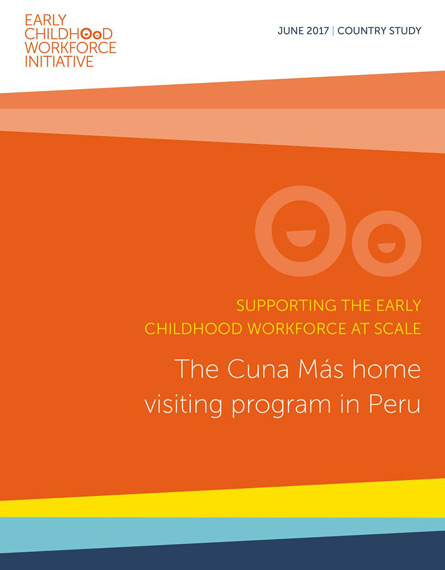Supporting the early childhood workforce at scale: The Cuna Más home visiting program in Peru
| Year | : | 2017 |
|---|---|---|
| Author/s | : | Kimberly Josephson, Gabriela Guerrero, Catherine Coddington |
| Area/s | : | Education and learning, Poverty and equality |
Josephson, K., Guerrero, G., & Coddington, C. (2017). Supporting the early childhood workforce at scale: The Cuna Más home visiting program in Peru. Washington, DC: Results for Development.
Early childhood development (ECD) policies and programs targeting young children and families, such as home visiting interventions, can positively impact a child’s development and lead to long-term health, education, and social benefits. These programs employ numerous professionals, paraprofessionals, and volunteers. A growing body of evidence demonstrates that it is essential for this early childhood workforce to be highly prepared and well-supported to ensure that young children have a strong foundation for healthy development and future success. Yet across sectors and countries, inadequate training, burdensome workloads, lack of supervision, poor wages, and other adverse conditions threaten the motivation and capacity of this workforce. The Early Childhood Workforce Initiative (ECWI) is a global effort to support practitioners. Under ECWI, a series of country studies will examine ways to strengthen and scale up a quality workforce. This first study focuses on Cuna Más, a large-scale ECD program in Peru that operates a home visiting service in rural areas. Home visiting is often used to reach vulnerable young children as well as their caregivers. Interventions typically involve regular, structured visits by a trained individual to a caregiver and child to improve parenting behaviors, the home environment, and impact child outcomes. The Cuna Más home visiting service enjoys relatively high coverage and early results are promising: a recent impact evaluation by the Inter-American Development Bank (IDB) found large effects on children’s cognitive and language development. However, operating at scale presents challenges to quality and sustainability.
This study is intended for home visiting program managers who want to understand the implementation challenges facing the workforce and learn how to overcome them. The country-level analysis and actionable policy recommendations in the study will be useful also for policymakers who want to improve the quality and scale of ECD services.







